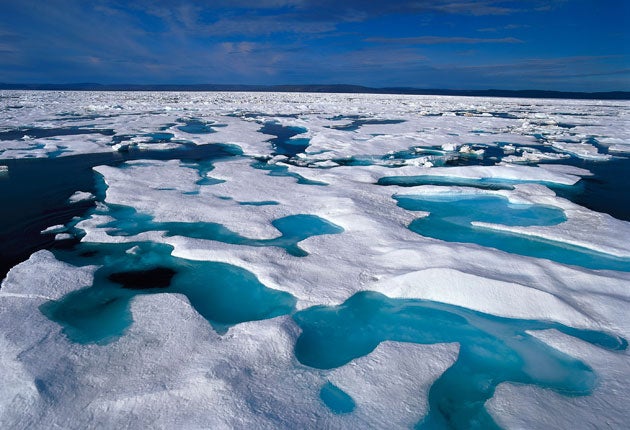Exclusive: The methane time bomb
Arctic scientists discover new global warming threat as melting permafrost releases millions of tons of a gas 20 times more damaging than carbon dioxide

Your support helps us to tell the story
From reproductive rights to climate change to Big Tech, The Independent is on the ground when the story is developing. Whether it's investigating the financials of Elon Musk's pro-Trump PAC or producing our latest documentary, 'The A Word', which shines a light on the American women fighting for reproductive rights, we know how important it is to parse out the facts from the messaging.
At such a critical moment in US history, we need reporters on the ground. Your donation allows us to keep sending journalists to speak to both sides of the story.
The Independent is trusted by Americans across the entire political spectrum. And unlike many other quality news outlets, we choose not to lock Americans out of our reporting and analysis with paywalls. We believe quality journalism should be available to everyone, paid for by those who can afford it.
Your support makes all the difference.The first evidence that millions of tons of a greenhouse gas 20 times more potent than carbon dioxide is being released into the atmosphere from beneath the Arctic seabed has been discovered by scientists.
The Independent has been passed details of preliminary findings suggesting that massive deposits of sub-sea methane are bubbling to the surface as the Arctic region becomes warmer and its ice retreats.
Underground stores of methane are important because scientists believe their sudden release has in the past been responsible for rapid increases in global temperatures, dramatic changes to the climate, and even the mass extinction of species. Scientists aboard a research ship that has sailed the entire length of Russia's northern coast have discovered intense concentrations of methane – sometimes at up to 100 times background levels – over several areas covering thousands of square miles of the Siberian continental shelf.
In the past few days, the researchers have seen areas of sea foaming with gas bubbling up through "methane chimneys" rising from the sea floor. They believe that the sub-sea layer of permafrost, which has acted like a "lid" to prevent the gas from escaping, has melted away to allow methane to rise from underground deposits formed before the last ice age.
They have warned that this is likely to be linked with the rapid warming that the region has experienced in recent years.
Methane is about 20 times more powerful as a greenhouse gas than carbon dioxide and many scientists fear that its release could accelerate global warming in a giant positive feedback where more atmospheric methane causes higher temperatures, leading to further permafrost melting and the release of yet more methane.
The amount of methane stored beneath the Arctic is calculated to be greater than the total amount of carbon locked up in global coal reserves so there is intense interest in the stability of these deposits as the region warms at a faster rate than other places on earth.
Orjan Gustafsson of Stockholm University in Sweden, one of the leaders of the expedition, described the scale of the methane emissions in an email exchange sent from the Russian research ship Jacob Smirnitskyi.
"We had a hectic finishing of the sampling programme yesterday and this past night," said Dr Gustafsson. "An extensive area of intense methane release was found. At earlier sites we had found elevated levels of dissolved methane. Yesterday, for the first time, we documented a field where the release was so intense that the methane did not have time to dissolve into the seawater but was rising as methane bubbles to the sea surface. These 'methane chimneys' were documented on echo sounder and with seismic [instruments]."
At some locations, methane concentrations reached 100 times background levels. These anomalies have been seen in the East Siberian Sea and the Laptev Sea, covering several tens of thousands of square kilometres, amounting to millions of tons of methane, said Dr Gustafsson. "This may be of the same magnitude as presently estimated from the global ocean," he said. "Nobody knows how many more such areas exist on the extensive East Siberian continental shelves.
"The conventional thought has been that the permafrost 'lid' on the sub-sea sediments on the Siberian shelf should cap and hold the massive reservoirs of shallow methane deposits in place. The growing evidence for release of methane in this inaccessible region may suggest that the permafrost lid is starting to get perforated and thus leak methane... The permafrost now has small holes. We have found elevated levels of methane above the water surface and even more in the water just below. It is obvious that the source is the seabed."
The preliminary findings of the International Siberian Shelf Study 2008, being prepared for publication by the American Geophysical Union, are being overseen by Igor Semiletov of the Far-Eastern branch of the Russian Academy of Sciences. Since 1994, he has led about 10 expeditions in the Laptev Sea but during the 1990s he did not detect any elevated levels of methane. However, since 2003 he reported a rising number of methane "hotspots", which have now been confirmed using more sensitive instruments on board the Jacob Smirnitskyi.
Dr Semiletov has suggested several possible reasons why methane is now being released from the Arctic, including the rising volume of relatively warmer water being discharged from Siberia's rivers due to the melting of the permafrost on the land.
The Arctic region as a whole has seen a 4C rise in average temperatures over recent decades and a dramatic decline in the area of the Arctic Ocean covered by summer sea ice. Many scientists fear that the loss of sea ice could accelerate the warming trend because open ocean soaks up more heat from the sun than the reflective surface of an ice-covered sea.
Join our commenting forum
Join thought-provoking conversations, follow other Independent readers and see their replies
Comments